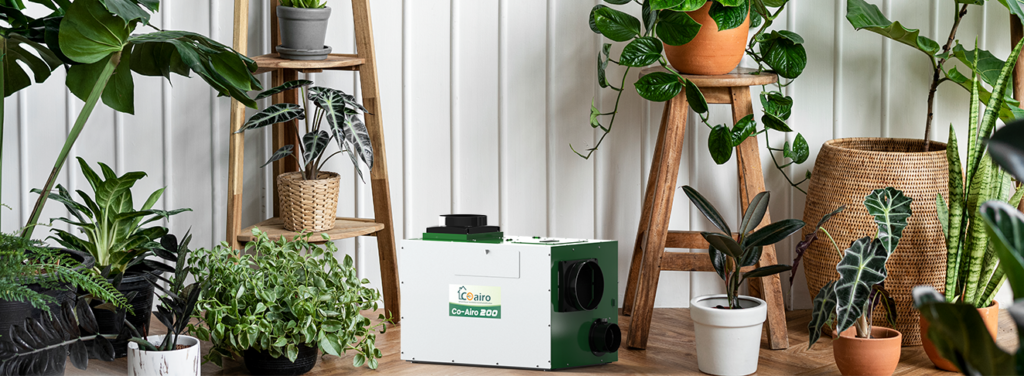When summer season starts, a greenhouse can trap more heat than plants can handle. Most plants grow well between 65°F and 80°F (18°C to 27°C) but when temperature starts getting hot, plants may wilt faster. You would notice their growth become slow and diseases spread quickly.
In this article, you’ll find 7 ways to keep your greenhouse cool during summer. So let’s start growing your favorite plants even when the heat is high.
How Hot Does a Greenhouse Get in Summer?
Summer heat can make greenhouses too hot for plants. If you live in a hot area, your garden can quickly turn dry and harsh like a desert.
In many parts of the United States, the inside temperature of a greenhouse can rise 30 to 40 degrees higher than the air outside if proper ventilation is not maintained.
| Region | States | Greenhouse Temperatures | Greenhouse Temperatures | Northern U.S. | Midwest, Northeast, Great Lakes (e.g., Michigan, New York, Wisconsin) | 70°F to 85°F (21°C to 29°C), occasionally exceeding 90°F (32°C) during heatwaves | 100°F to 120°F (38°C to 49°C) on hot days |
|---|---|---|---|
| Southern U.S. | Texas, Florida, Arizona, California | 85°F to 105°F (29°C to 41°C), occasionally exceeding 110°F (43°C) during heatwaves | 120°F to 130°F (49°C to 54°C) or higher during peak heat |
When sunlight enters a greenhouse and cannot escape, heat builds up quickly. Without airflow or shading, humidity rises and plants struggle to stay cool. Knowing these temperature patterns, gardeners can make early plans and maintain healthy, productive growth through summer.
Why Should You Keep Greenhouses Cool in Summer?
A cool greenhouse in summer allows plants to photosynthesize and absorb nutrients smoothly. When temperatures rise above 85°F (30°C), plants lose water faster than their roots can take it in.
They start protecting themselves and close their leaf pores which stops carbon dioxide from entering. Without enough carbon dioxide, photosynthesis slows down and plants start using stored energy instead of making new growth.
This heat stress makes stems weak, leaves smaller and fruit production lower. Even when plants survive, their quality drops. For example, tomatoes and cucumbers lose their sweetness and fruits in direct sunlight often develop pale or burnt spots.
7 Smart Ways to Cool Down Your Greenhouse
Keeping your greenhouse cool on summer hot days can be a challenging task. Here are 7 proven ways to keep your greenhouse cool and ensure your plants stay healthy and productive all summer long.
1. Ventilation
There are many ways gardeners can ventilate their greenhouse to maintain ideal temperature and bring in fresh air. For example, you can have a large garage type door open during the day in the summer season that keeps the greenhouse cool.
Ventilation fans on each side of the door pull hot air out of the greenhouse. The wind crossing the greenhouse keeps the air circulating quite nicely.
For larger greenhouses, pairing ventilation with a reliable dehumidifier can help maintain balanced moisture levels and create a stable environment for healthy plant growth.

2. Shading
Shade cloths are an excellent way to reduce the amount of direct sunlight entering your greenhouse. It is a fabric that is used to block different amounts of sunlight that is installed above the plants in a greenhouse to create a barrier.
Gardeners can also use hot tolerant trees that absorb heat and maintain a greenhouse environment. This method also offers effective shedding for greenhouse structure.

3. Insulation
Insulating barriers like thermal mass, screens can reflect heat away from the greenhouse walls or roof and maintain a cooler internal environment.
These barriers prevent heat and provide air space between layers. They are especially beneficial during the hottest days or in areas that expose intense sunlight.
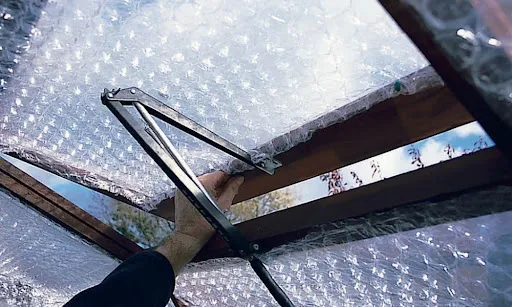
4. Positioning
Greenhouse position plays an important role in summer days. Position the greenhouse to minimize direct sunlight coming during peak hours. An east west orientation can reduce heat buildup.
Good positioning not only keeps temperature lower but also reduces the need for heavy shading or extra cooling systems.
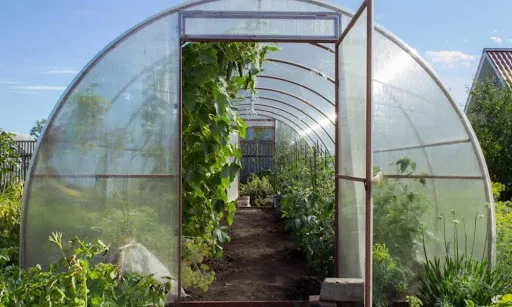
5. Watering & Monitoring
To avoid heat stress on summer days, water your plants regularly to keep them healthy and refreshing. You have to give a calculated amount of water to your plant to ensure better transpiration.
Greenhouses are delicate ecosystems that need constant attention and care. On the hottest days of summer, you can monitor your greenhouse temperature with a thermometer for the survival of plants.
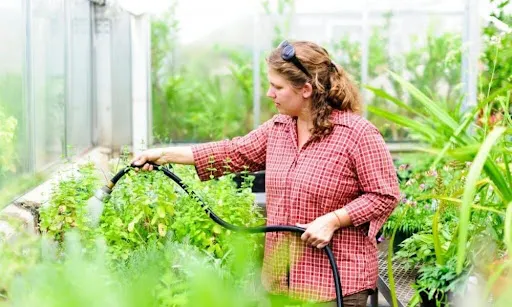
6. Cooling system
Fans circulate air in the greenhouse that lowers temperature and provides a cooling effect.
As we know that evaporation causes cooling, so an evaporating system can drop the temperature 10- 29 degrees inside the greenhouse as compared to the outside environment.
Cooling is provided through a misting system. It uses small nozzles along the ceiling that spray fine water droplets, creating evaporative cooling inside the greenhouse.
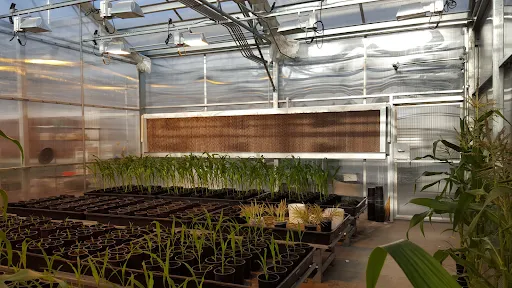
Maintain Ideal Humidity with a Greenhouse Dehumidifier
Stable humidity is key to healthy plant growth in summer. When moisture levels stay between 40% and 60%, plants absorb nutrients better and stay free from mold and pests.
A good greenhouse dehumidifier keeps this balance even on the hottest days. It controls excess moisture that can cause wilting, yellow leaves and lower yields.
Coairo Greenhouse Dehumidifiers maintain this perfect balance even during the hottest months. Designed for precision and durability, they prevent excess moisture that leads to wilting, yellow leaves and poor yields.
Visit Coairo to explore their full range of greenhouse dehumidifiers.
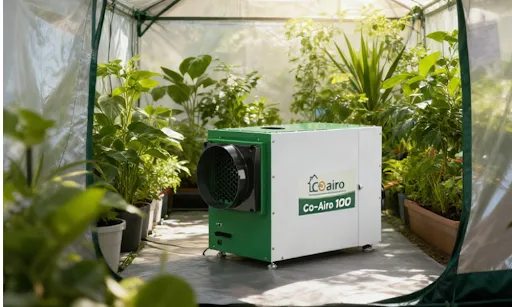
Additional Tips to Cool Greenhouse In Summer
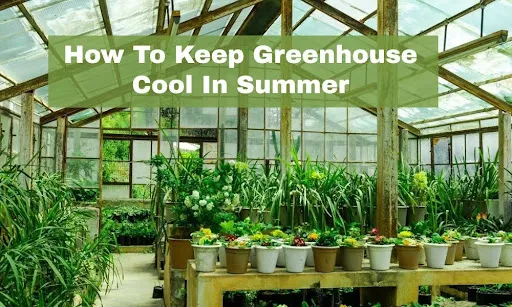
Besides all the above ways, a few extra tips can keep your greenhouse cool and comfortable during hot days. These simple steps make cooling more effective, help plants stay healthy and improve yield.
Regular maintenance of fans and vents
Make sure your fans and ventilations are clean and working properly because dust blocks airflow and reduces cooling efficiency. Steady humidity, supported by good ventilation or a dehumidifier keeps plants healthy in summer.
Remove unnecessary clutter to improve airflow
Too many tools or unused items inside the greenhouse can block air circulation. Keep the place organized so air can move freely that decreases humidity.
Monitor temperature with digital thermometers
Using a reliable thermometer helps you to keep checking on temperature changes throughout the day. This way quickly adjusts fans, shades and watering schedules when heat rises up.
Taking care of all these simple but important steps helps you to boost your overall greenhouse cooling. A clean and ventilated space protects plants from stress during summer days.
Conclusion
Keeping your greenhouse cool in summer depends on how well you manage temperature, airflow and humidity together. When these factors stay balanced, plants grow strong, healthy and productive.
Once you understand how heat affects your plants, you can take action early to prevent stress and damage. Every greenhouse is unique, but with regular care and observation, you can maintain the right conditions through the hottest months.
A clean, stable and well-ventilated greenhouse always rewards you with healthier plants and better harvests.


